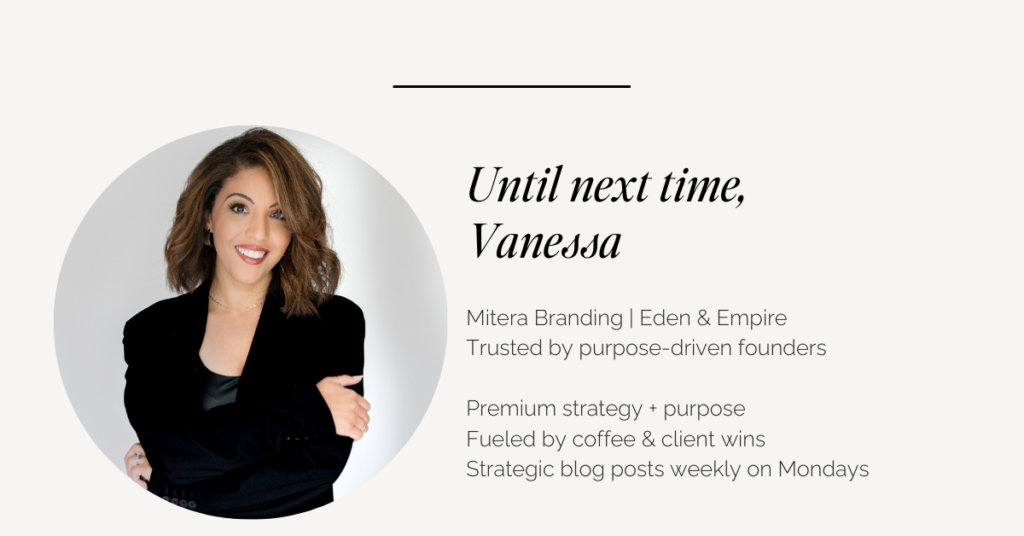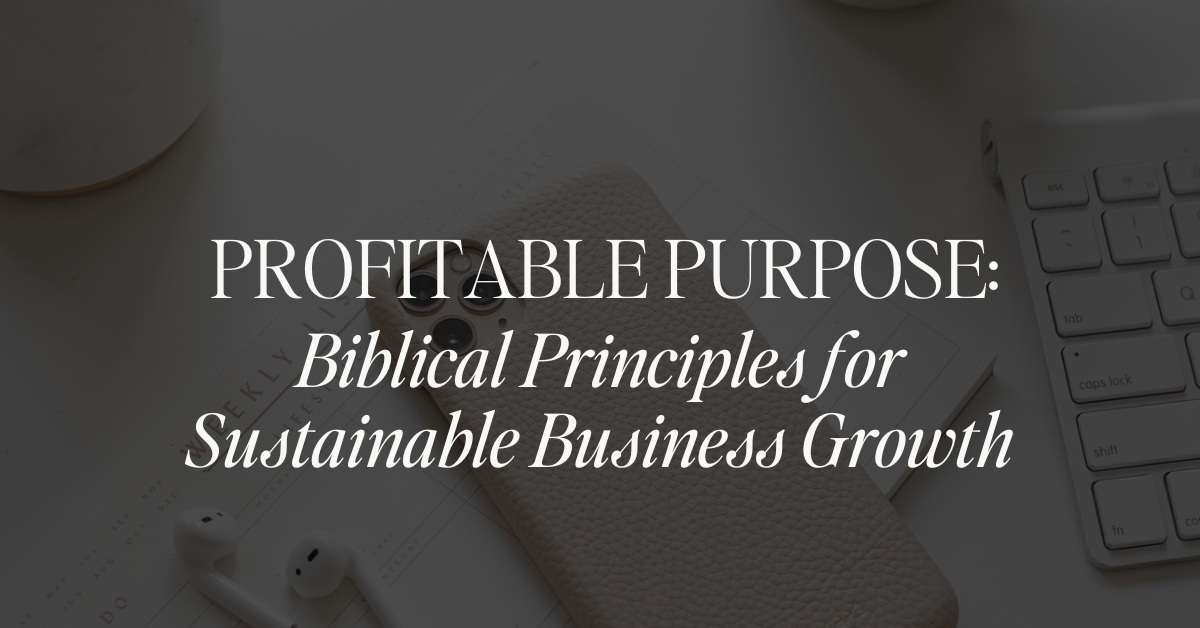Have you ever found yourself caught in that frustrating cycle? Your business is growing, revenue is increasing, but somehow it feels hollow—like you’re climbing a ladder that’s leaning against the wrong wall. Perhaps you’re hitting financial goals but sacrificing your wellbeing, relationships, or deeper sense of purpose along the way.
If you’re nodding right now, you’re in good company. Many entrepreneurs find themselves in this tension—building businesses that succeed financially but somehow miss the mark on meaningful impact or personal fulfillment.
Here’s what I’ve discovered in my years working with purpose-driven entrepreneurs: sustainable business growth isn’t just about smart strategies and systems (though those matter). It’s about building from a foundation of timeless principles that integrate profit and purpose rather than positioning them as competitors.
“What good is it for someone to gain the whole world, yet forfeit their soul?” This ancient wisdom speaks directly to today’s entrepreneurs. When we pursue profit at the expense of purpose, we often achieve growth that can’t be sustained—either because it burns us out or because it fails to fulfill our deeper reasons for being in business.
What if the growth breakthrough you’ve been seeking isn’t found in the latest marketing tactic or business trend? What if it’s about applying ageless wisdom to build a business that generates both profit and purpose in sustainable ways?
Let’s explore five timeless principles that can transform your approach to business growth—creating success that sustains not just your bank account but your sense of meaning and impact as well.
1. Build on the Principle of Stewardship, Not Ownership
“The earth is the Lord’s, and everything in it.” – Psalm 24:1

One of the most transformative shifts for entrepreneurs comes from embracing a stewardship mindset rather than an ownership perspective. This principle reminds us that our businesses, talents, and resources aren’t ultimately our own—they’re entrusted to us to manage and multiply for purposes beyond ourselves.
When we operate from stewardship rather than ownership, several powerful shifts occur:
- We make decisions considering impact beyond immediate profitability
- We recognize opportunity as responsibility rather than just personal gain
- We find freedom from the crushing weight of “it’s all up to me”
- We see our business as a vehicle for broader impact, not just personal success
- We gain perspective that reduces anxiety about short-term results
In practice, stewardship-based business growth might look like:
- Setting profitability goals that enable sustainability and impact, not just personal wealth
- Considering the impact of business decisions on employees, customers, and communities
- Viewing profit as fuel for purpose rather than the ultimate purpose itself
- Making reinvestment decisions based on both financial and impact returns
- Developing multiple “bottom lines” to measure success beyond just financial outcomes
Consider:
- How might a stewardship perspective change your growth strategies?
- What would change in your decision-making if you truly viewed your business as “entrusted” rather than “owned”?
- How could this principle help you navigate difficult business choices?
- What broader purposes might your business serve beyond generating profit?
2. Apply the Wisdom of Sowing and Reaping
“Do not be deceived: God cannot be mocked. A man reaps what he sows.” – Galatians 6:7
This timeless principle—that we harvest what we plant—explains why so many quick-growth strategies ultimately fail. When businesses prioritize short-term gains over creating genuine value, they often experience initial success that cannot be sustained.
The sowing and reaping principle reminds us that:
- Results follow the right inputs, not wishful thinking
- There’s a natural timing to growth that can’t always be accelerated
- What we focus on (sow) determines what we’ll eventually harvest
- The quantity and quality of what we sow affects what we reap
- We can’t harvest what we haven’t planted
For sustainable business growth, this principle suggests:
- Investing in value creation before expecting significant returns
- Prioritizing client/customer results as the foundation for business results
- Recognizing that some growth simply requires time and proper sequence
- Building marketing based on genuine impact rather than exaggerated claims
- Creating systems that deliver consistent quality, not just occasional excellence
To apply this principle to your growth strategy:
- Identify what you’re currently “sowing” in your business that will produce future results
- Consider what you need to start planting today for the harvest you want in 6-12 months
- Examine whether you’re trying to harvest results from seeds you haven’t actually planted
- Assess the quality and consistency of what you’re sowing
- Align your expectations with the natural laws of growth rather than demanding instant results

3. Honor the Rhythm of Rest and Production
“Six days you shall labor and do all your work, but the seventh day is a sabbath…” – Exodus 20:9-10
Perhaps no principle is more countercultural in today’s business environment than the necessity of regular rest. The unspoken assumption in many growth strategies is that more hours equal more results—a formula that inevitably leads to diminishing returns and eventual burnout.
This principle establishes that sustainable productivity requires intentional rhythms of work and rest—not as a concession to weakness but as a design feature of sustainable growth.
For business growth, this translates to:
- Building “breathing room” into your business model and schedule
- Recognizing that strategic pauses often lead to greater clarity and productivity
- Understanding that creativity and innovation typically emerge from rested minds
- Designing systems that don’t depend on constant personal availability
- Creating recovery periods after intensive business seasons
A growth strategy that honors this rhythm might include:
- Intentional boundaries around work hours and availability
- Regular periods for strategic thinking apart from day-to-day operations
- Sustainable pricing that doesn’t require constant overwork to be profitable
- Team structures that provide backup during rest periods
- Business planning that accounts for natural energy cycles, not just calendar cycles
Consider how you might implement this principle:
- Where are you currently operating without adequate rest and renewal?
- How might regular strategic pauses actually accelerate your growth?
- What systems need adjustment to honor sustainable rhythms?
- How could you design your ideal work/rest pattern in this season?
- What boundaries need to be established or reinforced?
4. Embrace the Power of Generous Business
“Give, and it will be given to you… For with the measure you use, it will be measured to you.” – Luke 6:38
While conventional business wisdom often focuses on maximizing extraction from every transaction, this principle suggests a different path to sustainable growth: generosity as a business strategy.
This isn’t about random acts of charity disconnected from your business model. It’s about building generosity into the very DNA of how your business operates—creating an abundance mindset that ultimately returns both financial and non-financial dividends.
Generous business practices might include:
- Creating genuine value beyond what customers explicitly pay for
- Establishing pricing models that are fair to all stakeholders
- Building opportunities to serve those who can’t afford your full offerings
- Sharing knowledge and resources openly rather than hoarding them
- Celebrating and supporting the success of competitors and collaborators
Entrepreneurs who embrace this principle often discover that:
- Generosity creates passionate advocates, not just satisfied customers
- Giving first often returns unexpected opportunities and connections
- An abundance mindset reveals possibilities that scarcity thinking misses
- Generosity attracts like-minded team members, partners, and clients
- Giving becomes a sustainable competitive advantage
To apply generous business principles:
- Audit your business model for opportunities to increase value-giving
- Consider what intellectual property or processes you might share more openly
- Look for ways to serve your market beyond what directly generates revenue
- Examine whether fear or scarcity thinking is limiting your approach
- Identify small generosity experiments you could implement immediately
5. Build with Integrity as Your Foundation
“Whoever walks in integrity walks securely, but whoever takes crooked paths will be found out.” – Proverbs 10:9
In an era of growth hacks and overnight success stories, this principle offers sobering wisdom: lasting success requires the foundation of integrity—doing what’s right even when it’s not immediately rewarded or recognized.
Integrity-based growth isn’t just an ethical choice; it’s a strategic advantage that:
- Creates trust that reduces friction in business relationships
- Builds reputation that attracts ideal clients and opportunities
- Eliminates the “tax” of maintaining appearances that don’t match reality
- Provides clarity in decision-making during challenging times
- Creates sustainable competitive advantage that can’t be easily copied
For sustainable business growth, integrity looks like:
- Marketing that creates realistic expectations you can consistently exceed
- Transparency about both the strengths and limitations of your offerings
- Admitting mistakes quickly and making them right for clients and team members
- Ensuring internal operations align with external messaging
- Making decisions that honor commitments even when circumstances change
To strengthen your integrity foundation:
- Identify any gaps between what you promise and what you deliver
- Look for places where short-term pressures might be tempting integrity compromises
- Consider how transparency could actually strengthen your client relationships
- Examine whether all stakeholders in your business are treated with equal integrity
- Recognize areas where greater integrity might temporarily slow growth but strengthen sustainability
Implementing Profitable Purpose
Building a business that generates both sustainable profit and meaningful purpose isn’t about implementing a few quick tactics. It requires intentionally designing your business model, operations, and growth strategies around timeless principles that integrate financial success with deeper impact.
This approach creates several distinctive advantages:
- Greater resilience during market fluctuations and challenges
- More sustainable growth that doesn’t require constant hustle
- Deeper satisfaction from work that aligns with your values
- Natural differentiation in crowded, commodity-driven markets
- Attraction of like-minded clients, team members, and partners
The journey begins with honest evaluation of your current business approach:
- Where is your business already aligned with these principles?
- Where do your growth strategies conflict with these timeless truths?
- Which principle resonates most strongly with your current business situation?
- What would need to change to bring greater alignment between profit and purpose?
From there, consider what intentional shifts would create greater integration between financial success and meaningful impact. These changes don’t require sacrificing profitability—in fact, they often enhance it by creating sustainable advantages that purely profit-driven competitors can’t easily replicate.
Unlock Your Profitable Purpose Blueprint
Ready to build a business that generates both sustainable profit and meaningful purpose? Download our free Profitable Purpose Blueprint – a practical framework for aligning your business model with the principles that create lasting success.
This isn’t about adding more complexity to your business. It’s about integrating timeless wisdom into your existing operations in ways that enhance both profitability and impact.
The Profitable Purpose Blueprint will help you:
- Identify conflicts between your current growth strategies and sustainable success principles
- Create practical systems for implementing purpose-driven approaches in your daily operations
- Develop decision-making filters that honor both profit goals and deeper purpose
- Design metrics that measure meaningful success, not just financial outcomes
- Build a concrete plan for a business model that generates both financial and purpose-driven results
Click here to download your free blueprint and take a meaningful step toward building a business that’s both profitable and purposeful.
What tensions have you experienced between profit goals and deeper purpose? Share your thoughts in the comments below—let’s learn from each other’s journeys!

